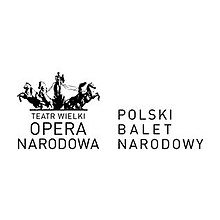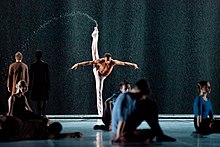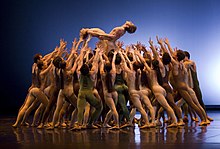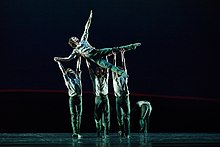Polish National Ballet
| Polish National Ballet | |
|---|---|
 | |
| General information | |
| Name | Polish National Ballet |
| Previous names | Balet Teatru Wielkiego – Opery Narodowej |
| Year founded | 1765 |
| Founders | Stanisław II August |
| Principal venue | Grand Theatre, Warsaw |
| Website | teatrwielki.pl |
| Artistic staff | |
| Artistic Director | Krzysztof Pastor |
| Other | |
| Formation |
|
The Polish National Ballet (Polish: Polski Balet Narodowy, PBN) is the largest and most influential ballet company in Poland. It continues a ballet heritage, dating to the 17th century.
Prior to 2008 it was known as the ballet of the Teatr Wielki - Polish National Opera. In that year the ballet company received artistic autonomy reflected in the theatre's by-laws; it was elevated to the rank of Polish National Ballet. The director since has been Polish choreographer Krzysztof Pastor.[1]
Ballet events in Polish history[edit]
It has been suggested that this section be split out into another article titled Polish ballet. (Discuss) (October 2023) |
Seventeenth century[edit]
In 1628 a traveling Italian opera troupe created the first ballet performances in Poland. Ballet scenes were then often incorporated into operas held at the court theater. For many years it was primarily foreign dancers who performed. They served as exemplars for their Polish counterparts.
Eighteenth century[edit]
Eventually in 1765 the first permanent ballet company was formed, on the initiative of the king Stanisław II August. The company functioned with some interruptions in the Saxon’s Opernhaus (opera house), the first Polish public theater. A 1766 book on ballet by the famous ballet master of France Jean-Georges Noverre was dedicated to the Polish king.[2]

Maciej Pręczyński (Prenczyński) was the first well-known Polish dancer. He worked with Gasparo Angiolini in Venice and in Vienna during the 1770s.
In 1785 Stanisław II August established a company of young dancers, taught by a ballet school at an estate in Lithuania. This first professional ballet company of predominantly Polish dancers was known as His Majesty’s National Dancers (1785-1794).[3] Performances were held on stage at the National Theatre building in Krasiński Square, Warsaw. Its royal heritage was continued by subsequent Polish companies.
Nineteenth century[edit]
In Warsaw uring the Romantic era the National Ballet School flourished. After 1818 it was guided by two French ballet masters Louis Thierry and Maurice Pion. Under construction from 1825 to 1833, the Teatr Wielki (Grand Theater) then became the artistic center for both opera and ballet in Poland. At mid-century the choreographer and teacher Roman Turczynowicz became the ballet master. Also, several outstanding foreign masters, e.g., Filippo Taglioni, Carlo Blasis, Virgilio Calori, Pasquale Borri, José Mendez, Raffaele Grassi, and Enrico Cecchetti, worked developing Polish dancers.[2]

Mathilde Kschessinska (Matylda Krzesińska), a dancer of Polish extraction, from the 1890s was one of the leading lights of the Imperial Theater in St. Petersburg.
Twentieth century[edit]
- Ballets Russes
From its early years many Polish dancers had joined the Ballets Russes of Sergei Diaghilev, which climbed to world renown. These included the ballet master Stanislas Idzikowski,[4] Leon Woizikovsky (orig. Wójcikowski),[2][5] and Mieczyslaw Pianowski.[6] Polish dancers also distinguished themselves in the various Ballets Russes companies that succeeded Diaghilev's. Among these were Yurek Shabelevski,[7][8] Roman Jasinski,[9][10] Marian Ladre,[11] Yurek Lazovski,[12][13][14] and Nina Novak.[15]
Siblings Bronislava Nijinska and Vaslav Nijinsky were of Polish heritage,[16] though Vatsa and Broni trained under the patronage of the Tsar at the Imperial Academy in St. Petersburg. They danced with Ballets Russes, Nijinsky being celebrated internationally as he reached the pinnacle of the art. Both were choreographers for Diaghilev, the older Nijinsky before the war, Nijinska during the 1920s.[17][18]
- Balet Polski

During the Second Polish Republic, Nijinska headed the Balet Polski, aka Les Ballets Polonais, aka The Polish Ballets newly formed in Warsaw in 1937.[19][20][21][22] This company was the brainchild of poet Jan Lechoń, and created with the assistance of M. Waclaw Jedrzejewicz, Minister of Public Education and President of the Organization Committee of the Polish Section to the Art and Technical Exhibition in Paris. The company's general director was Arnold Szyfman.
For the first season, 1937-1938, Nijinska created five new ballets including Baśń krakowska (La Légende de Cracovie), to music by Michal Kondracki; Pieśń o ziemi naszej (Le Chant de la Terre), to music by Roman Palester; Koncert E-moll Chopina (Concerto de Chopin), to Frédéric Chopin's B-minor piano concerto; Apollo i dziewczyna (Apollon et la Belle), to music by Ludomir Rozycki; and Wezwanie (Le Rappel), set to a score by Boleslaw Woytowicz. This repertoire featured scenery and costumes designed by Teresa Roszkowska, Waclaw Borowski, Wladyslaw Daszewski, and Irena Lorentowicz-Karwowska. The souvenir program for this company's Covent Garden appearances states: "Every gesture and every colour, the ebb and flow of the groups, each step of the soloists, the spirit and harmony of the Polish Ballets are imbued with the artistic ideals of Bronislava Nijinska and her ardent desire that the world should see the dances of her country in their noblest and most beautiful form."[23] At the Paris Exposition Internationale of that year, this Polish Ballet won the Grand Prix for performance, Nijinska the Gran Prix for choreography.[24][25] In 1938 the Ballets Polonais was directed by Leon Wójcikowski. It appeared at the New York World's Fair in 1939, but World War II caused its closure.[26]
- Ballet of Teatro Wielki
Following the traumas of war, the 'Ballet of Teatr Wielki' reemerged in Warsaw. Yet the original Teatr Wielki had been almost completely destroyed during the 1939 siege of Warsaw. Eventually it was rebuilt and enlarged, in a new facility (also called the Opera Narodowa [National Opera]). Continuing a heritage of several centuries, the new theater opened in 1965. It housed the companies and schools for both opera and ballet, its stage being shared.[27] The dance company later became the Polish National Ballet, which continues to rehearse and perform in Teatr Wielki.
Under new name and status[edit]














On 18 March 2009 Polish choreographer Krzysztof Pastor,[28] already engaged with the Dutch National Ballet, became the director of the ballet of Teatr Wielki - Polish National Opera. He took over this position with Paweł Chynowski as his proxy only under the condition that the company receive artistic autonomy. Thanks to the efforts of Teatr Wielki’s general director Waldemar Dąbrowski on 29 April 2009 the Polish Minister of Culture and National Heritage Bogdan Zdrojewski took the decision to separately constitute the ballet in the theater’s by-laws, under the name Polish National Ballet.[2] With the foundation of the Polish National Ballet, the company became autonomous and works as an equal partner to the Polish National Opera.
Polish National Ballet pursues a program of major classic dance formation. It performs an academic choreographic repertoire, but also reaches for 20th-century ballet masterpieces. Invitations are extended to outstanding contemporary choreographers; it also introduces works by young Polish choreographers. With nearly 90 dancers it includes both Polish and foreign dancers and affiliated specialities. The company performs regularly at the Teatr Wielki, when it is not on tour in Poland or performing abroad.
Repertoire, 2009-2023[edit]
Ballets staged by the Polish National Ballet from its establishing (year, ballet, choreographer):[29]
- 29 March 2009: Tristan by Krzysztof Pastor (Polish premiere)
- 3 April 2009: Romeo and Juliet by Emil Wesołowski (revival)
- 8 April 2009: Swan Lake by Marius Petipa, Lev Ivanov / Irek Mukhamedov (revival)
- 16 May 2009: Onegin by John Cranko / Georgette Tsinguirides (revival)
- 28 May 2009: La Bayadère by Marius Petipa / Natalia Makarova (revival)
- 10 June 2009: Anna Karenina by Alexei Ratmansky (revival)
- 24 June 2009: When You End and I Begin... by Robert Bondara (world premiere)
- 20 November 2009: Kurt Weill by Krzysztof Pastor (Polish premiere)
- 17 December 2009: The Nutcracker by Andrzej Glegolski (revival)
- 23 April 2010: In Search of Colours by Jacek Tyski (world premiere)
- 23 April 2010: Alpha Kryonia Xe by Jacek Przybyłowicz (revival)
- 9 May 2010: Chopin, the Romantic Artist by Patrice Bart (world premiere)
- 30 May 2010: The Sleeping Beauty by Marius Petipa / Yuri Grigorovich (revival)
- 25 June 2010: The Kisses by Emil Wesołowski (world premiere)
- 25 June 2010: Concerto Barocco by George Balanchine (Polish premiere)
- 25 June 2010: The Green by Ed Wubbe (Polish premiere)
- 25 June 2010: In Light and Shadow by Krzysztof Pastor (Polish premiere)
- 27 November 2010: Cinderella by Frederick Ashton / Wendy Ellis-Somes (Polish premiere)
- 27 March 2011: And the Rain Will Pass… by Krzysztof Pastor (world premiere)
- 11 June 2011: Le Sacre du printemps by Vaslav Nijinsky / Millicent Hodson (Polish premiere)
- 11 June 2011: The Rite of Spring by Emanuel Gat (Polish premiere)
- 11 June 2011: Le Sacre du printemps by Maurice Béjart (Polish premiere)
- 18 September 2011: Persona by Robert Bondara (world premiere)
- 25 November 2011: The Nutcracker and the Mouse King by Toer van Schayk and Wayne Eagling (Polish premiere)
- 14 April 2012: The Prodigal Son by George Balanchine (Polish premiere)
- 14 April 2012: Cain and Abel by Emil Wesołowski (world premiere)
- 14 April 2012: Six Wings of Angels by Jacek Przybyłowicz (world premiere)
- 17 November 2012: Century Rolls by Ashley Page (world premiere)
- 17 November 2012: Moving Rooms by Krzysztof Pastor (Polish premiere)
- 17 November 2012: Artifact Suite by William Forsythe (Polish premiere)
- 15 March 2013: A Midsummer Night’s Dream by John Neumeier (Polish premiere)
- 13 October 2012: Weill Suite by Krzysztof Pastor (premiere)
- 13 October 2012: Afternoon of a Faun by Jacek Tyski (world premiere)
- 3 October 2013: Hamlet by Jacek Tyski (world premiere)
- 7 March 2014: Romeo and Juliet by Krzysztof Pastor (Polish premiere)
- 29 March 2014: Adagio & Scherzo by Krzysztof Pastor (world premiere)
- 29 March 2014: Returning Waves by Emil Wesołowski (revival)
- 29 May 2014: Don Quixote by Marius Petipa, Aleksandr Gorski / Alexei Fedeyechev (premiere)
- 15 November 2014: Nevermore...? by Robert Bondara (world premiere)
- 15 November 2014: Soldiers' Mass by Jiří Kylián (Polish premiere)
- 15 November 2014: The Green Table by Kurt Jooss / Jeanette Vondersaar (Warsaw premiere)
- 14 February 2015: Pupa by Anna Hop (world premiere)
- 28 May 2015: Casanova in Warsaw by Krzysztof Pastor (world premiere)
- 27 November 2015: The Taming of the Shrew by John Cranko / Jane Bourne (Polish premiere)
- 9 April 2016: The Tempest by Krzysztof Pastor (Polish premiere)
- 25 November 2016: Chopiniana by Mikhail Fokine / Alexei Fadeyechev (premiere)
- 25 November 2016: Bolero by Krzysztof Pastor (Polish premiere)
- 25 November 2016: Chroma by Wayne McGregor (Polish premiere)
- 20 May 2017: Swan Lake by Krzysztof Pastor (world premiere with new libretto)
- 14 June 2017: Darkness by Izadora Weiss (world premiere)
- 10 November 2017: Świtezianka by Robert Bondara (premiere)
- 10 November 2017: On a Stave (Tansman's Sextuor) by Jacek Tyski (Polish premiere)
- 10 November 2017: Szymanowski's Violin Concerto no. 2 by Jacek Przybyłowicz (world premiere)
- 20 April 2018: Lady of the Camellias by John Neumeier (Polish premiere)
- 17 November 2018: Chopin's Concerto in E minor by Liam Scarlett (world premiere)
- 17 November 2018: Chopin's Concerto in F minor by Krzysztof Pastor (world premiere)
- 31 December 2018: Moniuszko's Polish Dances - Polonaise & Mazurka by Krzysztof Pastor (world premiere)
- 6 April 2019: Sarmatian Parable after Fredro's Zemsta by Conrad Drzewiecki / Emil Wesołowski (Warsaw premiere)
- 6 April 2019: Husband and Wife after Fredro by Anna Hop (world premiere)
- 25 April 2019: Kilar's Toccata by Krzysztof Pastor (world premiere)
- 16 October 2019: Le Noces by Bronislawa Nijinska (Polish premiere)
- 16 October 2019: Do Not Go Gentle… by Krzysztof Pastor (Polish premiere)
- 16 October 2019: Infra by Wayne McGregor (Polish premiere)
- 17 September 2020: Le Corsaire by Manuel Legris after Marius Petipa (premiere)
- 16 December 2020: Kilar's Preludium by Krzysztof Pastor (world premiere at the Dance Open Festival, Saint Petersburg)
- 4 June 2021: Mayerling by Kenneth MacMillan (Polish premiere)
- 13 November 2021: Exodus by Anna Hop (world premiere)
- 13 November 2021: Flights-Harnasie by Izadora Weiss (world premiere)
- 28 April 2022: Dracula by Krzysztof Pastor (Polish premiere)
- 25 November 2022: Giselle by Jean Coralli, Jules Perrot, Marius Petipa / Maina Gielgud (premiere)
- 18 May 2023: Grosse Fuge by Hans van Manen (Polish premiere)
- 18 May 2023: Eroica Variations by Ted Brandsen (world premiere)
- 18 May 2023: Seventh Symphony by Toer van Schayk (Polish premiere)
- 21 April 2024: Pinocchio by Anna Hop (premiere) in plan
Leading soloists, 2009-2024[edit]
| Principal female dancers | Principal male dancers |
|---|---|
|
|
| First female soloists | First male soloists |
|---|---|
|
|
On tour[edit]
- 2010: Russia, Saint Petersburg, Mariinsky Theatre, 18th White Night Music Festival (Chopin, the Romantic Artist x 2)
- 2010: China, Shanghai, Shanghai Oriental Art Center, Expo 2010 (Chopin, the Romantic Artist x 2)
- 2010: Norway, Bergen, Den Nye Opera, Bergen, Norway (When You End and I Begin... / In Search of Colours / Alpha Kryonia Xe x 3)
- 2012: Spain, Sevilla, Teatro de la Maestranza (La Bayadère x 5)
- 2012: Finland, Kuopio, Music Centre, Kuopio Dance Festival (Weill Suite / When You End and I Begin... / Afternoon of a Faun / The Green x 2)
- 2013: USA, Houston, Cullen Theater, Dance Salad Festival (Kurt Weill / And the Rain Will Pass... / Moving Rooms / Persona – excerpts x 3)
- 2013: Spain, Barcelona, Gran Teatre del Liceu (The Kisses / Concerto Barocco / The Green / In Light and Shadow x 4)
- 2013: Lithuania, Vilnius, Lithuanian National Opera and Ballet Theatre (Century Rolls / Moving Rooms / Artifact Suite x 2)
- 2015: USA, New York, Joyce Theatre (Adagio & Scherzo / The Rite of Spring by Emanuel Gat / Moving Rooms x 7)
- 2015: USA, Washington, Eisenhower Theater (Adagio & Scherzo / The Rite of Spring by Emanuel Gat / Moving Rooms x 1)
- 2016: Netherlands, The Hague, Zuiderstrandtheater (Romeo and Juliet x 2)
- 2016: Lithuania, Vilnius, Lithuanian National Opera and Ballet Theatre, Krzysztof Pastor’s Birthday Gala (Adagio / Moving Rooms x 1)
- 2017: Russia, Saint Petersburg, Alexandrinsky Theatre, Dance Open Festival (The Tempest x 1)
- 2018: Czech Republic, Brno, Exhibition Centre, Festival Dance Brno 100 (Chopiniana / Moving Rooms / Bolero x 1)
- 2019: Canada, Montreal, Place des Arts (Swan Lake x 10)[54]
- 2019: Russia, Saint Petersburg, Alexandrinsky Theatre, Dance Open Festival (Toccata x 1)
- 2019: Germany, Osnabrück, Theater Osnabrück (Toccata x 1)
- 2019: Lithuania, Vilnius, Lithuanian National Opera and Ballet Theatre (Toccata x 1)
- 2020: Russia, Saint Petersburg, Oktyabrsky Big Concert Hall, Dance Open Festival (Preludium x 1)
- 2022: Germany, Hamburg, Hamburg State Opera - Main Stage, 47th Hamburg Ballet Days (The Tempest x 2)
- 2022: Netherlands, Amsterdam, Dutch National Opera & Ballet, 60th Anniversary Gala Dutch National Ballet (Toccata x 1)
- 2022: Finland, Lappeenranta, City Theatre, Lappeenranta Ballet Gala (Tristan and Isolde-Pas de deux & Moving Rooms x 2)
- 2022: Hungary, Győr, National Theatre of Győr (Husband and Wife x 1)
See also[edit]
- Italian ballet
- French ballet
- Russian ballet
- Royal Danish Ballet
- The Royal Ballet
- Cuban National Ballet
- Opéra National de Lyon
References[edit]
- ^ Cf. Polish National Ballet at website Teatr Wielki / Opera Narodowa. Accessed 7 April 2017.
- ^ a b c d Paweł Chynowski, History of the Polish National Ballet. Accessed 7 April 2017.
- ^ Halina Goldberg, The Age of Chopin (Indiana University 2004), p. 110. Accessed 2-17-04-11.
- ^ Cyril W. Beaumont, The Art of Stanislas Idzikowski (London: Beaumont Press, 1926), pp. 7-8. Idzikowski (1894-1977) was ten when he started at the ballet school in Teatr Wielki. After his debut, when sixteen he left for London. In a few years Diaghilev asked him to join Ballets Russes.
- ^ Haskell, Arnold, ed. (1940). Ballet to Poland. New York: The MacMillan Company. pp. 29–32.
- ^ "Diaghleff's Ballet Russe". Boston Sunday Post. 26 December 1915. p. 27. Retrieved 20 February 2021 – via NewspaperArchive.com.
- ^ "Biography of Yurek Shabelevsky". The Biography.
- ^ Chujoy, Anatole (1949). The Dance Encyclopedia. New York: A.S.Barnes and Company. p. 426.
- ^ Koegler, Horst (1977). The Concise Oxford Dictionary of Ballet. New York: Oxford University Press. p. 280.
- ^ Chujoy, Anatole (1949). The Dance Encyclopedia. New York: A.S.Barnes and Company. p. 265.
- ^ Chujoy, Anatole (1949). The Dance Encyclopedia. New York: A.S. Barnes and Company. pp. 280–281.
- ^ Haskell, Arnold L., ed. (1940). Ballet--To Poland. New York: The MacMillan Company. p. 9.
- ^ Koegler, Horst (1977). The Concise Oxford Dictionary of Ballet. New York: Oxford University Press. p. 318.
- ^ Chujoy, Anatole (1949). The Dance Encyclopedia. New York: A.S. Barnes and Company. p. 285.
- ^ Koegler, Horst (1977). The Concise Oxford Dictionary of Ballet. New York: Oxford University Press. p. 390.
- ^ Bronislava Nijinska, Early Memoirs (New York: Holt Rinehart Winston 1981), pp. 3-13. Both parents (1891-1972) were professional ballet dancers who'd been trained at Teatr Wielki.
- ^ Lynn Garafola, Diaghilev's Ballets Russes (Oxford University 1989), 122-134 (Nijinska); ix, 376 (reference to her Théâtre de la Danse [Paris 1932-1934] that "carried on Diaghilev's experimental tradition").
- ^ Agnes de Mille, The Book of the Dance (London: Paul Hamlyn 1963), pp. 152-153 (Bronislava Nijinska).
- ^ Turska, Irena (1983). Krótki Zarys Historii Tańca i Baletu. Polskie Wydawnictwo Muzyczne. pp. 268–270.
- ^ Mamontowicz-Łojek, Bozena. Terpsychora i lekkie muzy: Taniec widowiskowy w Polsce w okresie międzywojennym (1918-1939). Polskie Wydawnictwo Muzyczne. pp. 59–64.
- ^ Wysocka, Tacjanna. Dzieje Baletu. pp. 436–438.
- ^ Arkin, Lisa C. (Fall 1992). "Bronislava Nijinska and the Polish Ballet, 1937-1938: Missing Chapter of the Legacy". Dance Research Journal. 24/2 (2): 1–16. doi:10.2307/1478521. JSTOR 1478521. S2CID 191992687.
- ^ The Polish Ballets. London: Towarzystwo Polskich Widowisk Artystycznych S.A. 1937.
- ^ Nijinska, Early Memoirs (1981), pp. 521-522.
- ^ Nancy Van Norman Baer, Bronislava Nijinska. A Dancer's Legacy (Fine Arts Museum of San Francisco 1986), pp. 65-66.
- ^ Nancy Reynolds and Malcolm McCormack, No Fixed Points. Dance in the twentieth century (Yale University 2003), p. 181 (the Polish ballet company).
- ^ Paweł Chynowski, History of the Polish National Ballet. Accessed 11 April 2017.
- ^ Krzysztof Paster at Culture.pl. Accessed 2017-04-11.
- ^ Polish National Ballet at website Teatr Wielki / Opera Narodowa. Accessed 7 April 2017.
- ^ "Chinara Alizade". Teatr Wielki Opera Narodowa. Retrieved 27 May 2018.
- ^ "Yuka Ebihara". Teatr Wielki Opera Narodowa. Retrieved 27 May 2018.
- ^ "Dawid Trzensimiech". Teatr Wielki Opera Narodowa. Retrieved 27 May 2018.
- ^ "Patryk Walczak". Teatr Wielki Opera Narodowa. Retrieved 6 July 2018.
- ^ "Maksim Woitiul". Teatr Wielki Opera Narodowa. Retrieved 27 May 2018.
- ^ "Vladimir Yaroshenko". Teatr Wielki Opera Narodowa. Retrieved 27 May 2018.
- ^ "Melissa Abel". Teatr Wielki Opera Narodowa. Retrieved 13 August 2022.
- ^ "Magdalena Ciechowicz". Teatr Wielki Opera Narodowa. Retrieved 27 May 2018.
- ^ "Dagmara Dryl". Teatr Wielki Opera Narodowa. Retrieved 27 May 2018.
- ^ "Marta Fiedler". Teatr Wielki Opera Narodowa. Retrieved 27 May 2018.
- ^ "Jaeeun Jung". Teatr Wielki Opera Narodowa. Retrieved 7 September 2023.
- ^ "Karolina Jupowicz". Teatr Wielki Opera Narodowa. Retrieved 27 May 2018.
- ^ "Mai Kageyama". Teatr Wielki Opera Narodowa. Retrieved 27 May 2018.
- ^ "Dominika Krysztoforska". Teatr Wielki Opera Narodowa. Retrieved 27 May 2018.
- ^ "Aleksandra Liashenko". Teatr Wielki Opera Narodowa. Retrieved 27 May 2018.
- ^ "Izabela Milewska". Teatr Wielki Opera Narodowa. Retrieved 27 May 2018.
- ^ "Maria Żuk". Teatr Wielki Opera Narodowa. Retrieved 27 May 2018.
- ^ "taniec POLSKA [pl] - people - Sergey Basalaev". www.taniecpolska.pl. Retrieved 27 May 2018.
- ^ Staatsoper, Wiener. "Robert Gabdullin - Ballet - Artists - Wiener Staatsoper". www.wiener-staatsoper.at. Retrieved 27 May 2018.
- ^ "Ryota Kitai". Teatr Wielki Opera Narodowa. Retrieved 7 September 2023.
- ^ "Paweł Koncewoj". Teatr Wielki Opera Narodowa. Retrieved 27 May 2018.
- ^ "Home". www.egormenshikov.com. Retrieved 27 May 2018.
- ^ "Sergey Popov leaves PNB". Retrieved 27 May 2018.
- ^ "Wojciech Ślęzak". Teatr Wielki Opera Narodowa. Retrieved 27 May 2018.
- ^ "PBN goes to Montreal". teatrwielki.pl. Retrieved 2 March 2019.
External links[edit]
